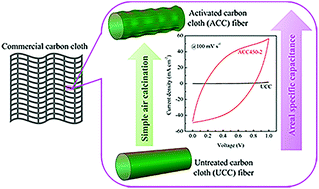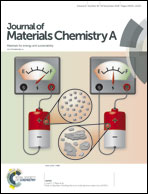Simple air calcination affords commercial carbon cloth with high areal specific capacitance for symmetrical supercapacitors†
Abstract
Carbon cloth textiles are widely used in high-performance flexible, portable and low-cost supercapacitors. Herein, a simple calcination in air at 450 °C was developed to activate commercial carbon cloth textiles to achieve a significantly improved specific surface area and in turn outstanding electrochemical performances for supercapacitors. The areal capacitance of the activated carbon cloth (ACC) electrode is 1184 times that of the untreated one (1136.7 vs. 0.96 mF cm−2 at 2 mV s−1), mainly due to the introduced surface oxygen functional groups, the remarkably improved specific surface area, and the greatly enhanced hydrophobicity. The full-cell symmetric supercapacitor constructed with ACC shows an areal specific capacitance of 554 mF cm−2 and an energy density of 77 μW h cm−2 at 1 mA cm−2 with a superior rate capability (retaining 70 μW h cm−2 at 50 mA cm−2) and a good cycling stability of up to 50 000 cycles. Furthermore, ACC can serve as an excellent scaffold for supporting other capacitive materials (e.g., TiO2 nanowires) to further improve the areal capacitance. The current investigation provides an extremely simple route to significantly improve the electrochemical performances of ACC-based electrodes for supercapacitors. It also evidences the significant contributions of carbon cloth to specific capacitance when it is used as a substrate to load electrochemically active materials and at the same time the synthetic route involves air calcination at a temperature above 450 °C.



 Please wait while we load your content...
Please wait while we load your content...